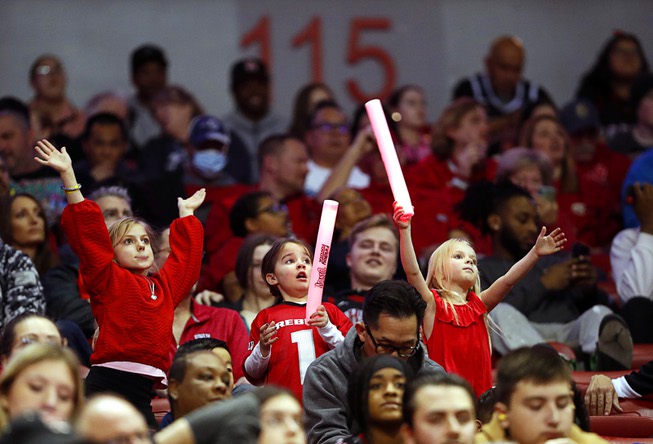
UNLV fans cheer during the Dec. 31, 2022, against San Diego State at the Thomas & Mack Center. The Las Vegas area has long returned to its pre-COVID ways with tourism booming, entertainment and sports venues packed and COVID-19 restrictions lifted. With few exceptions, including one fan near the rear center of this gathering, there’s no mask-wearing, social distancing or other precautions. Yet, health officials say the area could experience a spike in COVID cases this summer.
Tuesday, May 2, 2023 | 2 a.m.
COVID in Las Vegas
- Bill to end pandemic safety measures wins praise from resort industry in Nevada, barbs from union
- Former Gaming Control Board chair talks COVID, virtual reality and life off the board
- Conventions, athletic events help spur post-pandemic visitation to Las Vegas in 2022
- Southern Nevada public health officials, recognizing vaccine burnout, continue to push COVID shots
A summer COVID-19 wave might be on the horizon for Southern Nevada, although local experts say it likely will be more calm than past years.
“COVID is very hard to predict,” said Kimberly Franich, a communicable disease manager at the Southern Nevada Health District. “We do see historical patterns of spikes during the July to August months dating back all the way to 2020, summer 2021 and then again in 2022. If it is reflective of the historical pattern, we may see some increases, but it’s hard to say.”
Large gatherings and close contact with infected individuals can drive transmission, Franich said, and with the summer months forcing Southern Nevadans into air-conditioned spaces, the spread of COVID could increase.
A similar trend occurred in the winter months, when people stayed indoors to avoid cold temperatures. From November 2022 to February 2023, the hospitals in the county combined to have an average of 200 patients at any given time with the virus, according to the Nevada Hospital Association.
“Over the past three years, we can see that we did have that spike over the wintertime, but it was far less and that can be attributed to a number of things, including the variant that was circulating at the time, along with all of the immunity that our community has both with our vaccination and naturally,” Franich said.
The Las Vegas area has long returned to its pre-COVID ways.
Tourism is booming, entertainment venues are packed and restrictions have been lifted. With few exceptions, there’s no mask-wearing, social distancing or other precautions.
Fittingly, Clark County is listed as having low community impact levels of COVID-19, according to the Centers for Disease Control and Prevention. And Dr. Christopher Lake, executive director of community resilience at the Nevada Hospital Association, said public health officials are “just not seeing any indication around the world of any insurgence” during the summer months like in past years.
But some residents are still getting sick.
As of Monday, Nevada Health Response reported a 14-day moving average of 80 people a day testing positive for COVID-19 in the Silver State. It’s down from the 194 that were testing positive for the virus around the same time last year, according to the state’s dashboard.
The last time the dashboard reported any deaths on its 14-day moving average was April 8, when the average stood at 1.
Franich said hospitalizations have been “pretty consistent,” with an average of about 12 COVID-positive people being admitted a day. That means COVID certainly is circulating in the community, she said, and the Centers for Disease Control and Prevention list the county as having high levels of community transmission.
In late-April, there were about 87 people hospitalized statewide because of COVID-19, according to the Nevada Hospital Association. Fifteen of those patients were being treated in intensive care units.
The data, Franich warns, won’t tell the complete picture because a lack of testing, and access to home-testing kits makes it harder for health officials to accurately capture all positive COVID cases. President Joe Biden last month ended the national emergency order effective May 11, meaning insurance plans will no longer be required to cover the full cost of over-the-counter tests — although some have elected to still do. Because COVID vaccines and boosters fall under the category of a preventive health service, most private insurance plans will continue to fully cover them without a co-pay, according to the CDC.
Regardless, Franich said it’s important for individuals to take steps that ensure they decrease their risk of contracting COVID.
Those steps include phrases that have been thrown around many times throughout the past three years: stay home if you’re sick, consider masking especially around immunocompromised people, and get vaccinated if you can.
About 56% of Clark County residents have been vaccinated with at least one dose as of April 2023, and roughly 37% have followed up with one or more boosters, reports the Nevada Health Response.
“At this point, we are all very well educated (on) COVID, how COVID can be transmitted and taking precautions,” Franich said. “I think it’s important to remember that though the public health emergency is ending, certainly those tools can be used on an individual level, and we can protect ourselves and make good decisions.”
